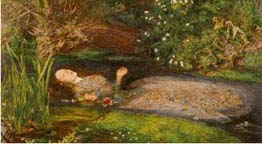 Sir John Everett Millais's Ophelia depicts a calm, drowning Ophelia surrounded by lush, blooming nature. Shakespeare's Ophelia, mad with grief, falls while picking flowers. Millais presents her floating in the water, her head, hands, and dress not yet submerged. The dark pool of water at her stomach on which her garland of flowers floats hints that rest of her body will soon sink below the surface. Ophelia's expression shows no panic or despair. Her skin glows with life yet, not death. She gazes up, mouth open in song, and her position recalls a Christlike pose, much like Dürer's Man of Sorrows with Hands Raised. The looming leaves and brush around her seem to swallow her as much as the water does. The flowers and green brush on the far bank and the brown willow reach out over her, while the green in the foreground closes in on her. Millais has not generalized the flowers on the bank or in her garland. He carefully renders the poppies and violets as symbols of her death and faithfulness.
Sir John Everett Millais's Ophelia depicts a calm, drowning Ophelia surrounded by lush, blooming nature. Shakespeare's Ophelia, mad with grief, falls while picking flowers. Millais presents her floating in the water, her head, hands, and dress not yet submerged. The dark pool of water at her stomach on which her garland of flowers floats hints that rest of her body will soon sink below the surface. Ophelia's expression shows no panic or despair. Her skin glows with life yet, not death. She gazes up, mouth open in song, and her position recalls a Christlike pose, much like Dürer's Man of Sorrows with Hands Raised. The looming leaves and brush around her seem to swallow her as much as the water does. The flowers and green brush on the far bank and the brown willow reach out over her, while the green in the foreground closes in on her. Millais has not generalized the flowers on the bank or in her garland. He carefully renders the poppies and violets as symbols of her death and faithfulness.
The attention to detail--in the natural setting, the fading glimmer of her gown, and her elegant repose--characterizes a Pre-Raphaelite style, but here the effect of these details seems more poignant. Millais has captured a specific, fleeting moment just after her fall but before her death, and he has immortalized Ophelia. Every reflection and flick of light give the impression of frozen time, and it suggests that Ophelia, though unchanging on the canvas before the viewer, had not always been so close to death and would not remain afloat much longer. Millais painting presents a crystallized moment between life and death.
Questions
1. Ophelia raises her hands in a pose of offering or prayer. Did Millais do this intentionally? Does this Christlike or pious pose make Ophelia a figure of sacrifice? Or is it not allegorical and simply adding to the aesthetic, emotional value of the painting?
2.What are some possible reasons for the juxtaposition of Ophelia with the lush, natural setting?
3. Why do you think Millais chose to paint this moment of Ophelia's tragedy, rather than her lifeless body or Ophelia in grief? What is the emotional effect of Ophelia's position as Millais painted her?
Bibliography
Millais, John Guile. The Life and Letters of John Everett Millais, President of the Royal Academy. 2 vols. New York: Frederick A. Stokes, 1899.
The Pre-Raphaelites. London: Tate Gallery/Allen Lane, 1984. No. 32. P. 86.
Last modified 17 September 2004